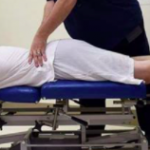Sciatica

Sciatica is the term often given to nerve pain travelling down the leg.
- Symptoms can include weakness, numbness, pins and needles, electric shock sensations, and aching.
- The pain can vary from infrequent and irritating, to constant and incapacitating.
- You will not do any harm by keeping mobile and staying at work. This can often be beneficial although you may need to adapt the way you do certain activities, and get up from sitting more frequently
- You may need to shorten the amount of activity you do at first such as walking or swimming, but these activities can be built up gradually over time
- Perform some gentle back stretches to maintain flexibility in your spine and reduce constant pressure on your nerves and discs.
- For Sciatica, you (and ideally a therapist trained in nerve entrapments) need to find where the nerve might be compressed, entrapped or irritated.
Anatomy
- It can start in the lower back where the nerves exit (vertebral foramen – space between the vertebral bodies where the nerves exit before combining to form the sciatic nerve).
- The sciatic nerve then travels deep to your lower back (lumbar) muscles, behind (anterior to) the Ilium and exits through a bony (sciatic) notch deep to the glutes.
- From here the sciatic nerve travels under the piriformis muscle. If the sciatic nerve is agitated or irritated (pinched/impinged) here this is called Piriformis Syndrome.
- After passing under (or in some people through) the piriformis muscle, the sciatic nerve passes between/under the hamstring before branching and continuing into the lower leg and foot.
Symptoms
- One of the feature characteristics of sciatica is that symptoms can travel past the knee.
- With Sciatica, the leg below the entrapment/aggravation site can become weaker, painful and/or with associated numbness and tingling.
- There can be other referral sources such as from Sacroiliac (SI) joint or lower back/glutes where the referral does NOT go past the knee.
- Sciatic pain can also be from spianl disc pathology and imaging (MRI etc.) may be needed.
Treatment and Rehab
- The treatment for Carpal Tunnel Syndrome/symptoms and Sciatica and other nerve pinches, impingement or entrapments needs to be very specific to achieve relative movement between the nerve and these adjacent structures.
- Nerves do not like to be stretched.
- Therefore, Rehab should include exercises that don’t pull the nerve from both ends. This is often referred to as Nerve Flossing. Nerve Flossing includes movements that move the nerve back and forth (like flossing your teeth) between muscles and other soft tissue structures in order to free up the nerve from these entrapments without tugging on the nerve from both ends.
- Once the entrapment site is identified, the goal of treatment is targeted to create a permanent release by creating space so symptoms resolve and more chronic or permanent nerve damage is prevented.
- Identifying the aggravating or causational factor is important. This way, we can remove or modify activities and strengthen and stretch the surrounding area to avoid a recurrence of Sciatica.
Treatments are severity, phase and pain based
- Treatments may include: Active Release Techniques (scar tissue release and mobility), Class 3B or 4 laser (penetrates into the soft tissues to promote healing and reduce inflammation) and/or Chiropractic (if necessary, at your discretion and with your consent),
- Stretching and rehabilitative exercises
- Often, 3-6 treatments are required for significant improvement/healing.
If you experience any of the following symptoms contact your clinician URGENTLY:
- An inability to pass urine when you feel that you need to go.
- Loss of control of your bowels.
- Numbness around your genital area.
- Inability to get an erection.
- Worsening weakness in both legs